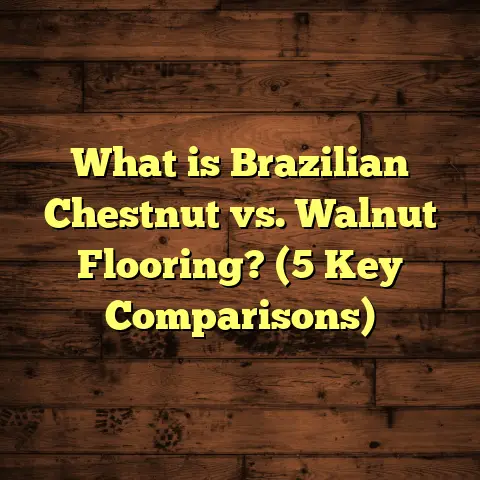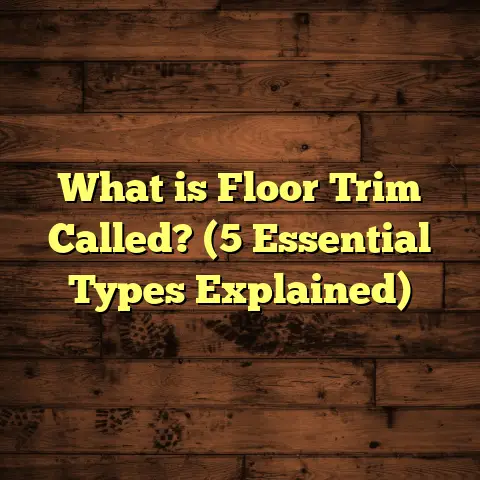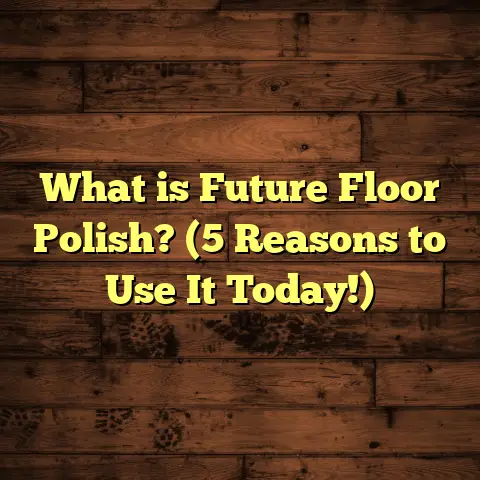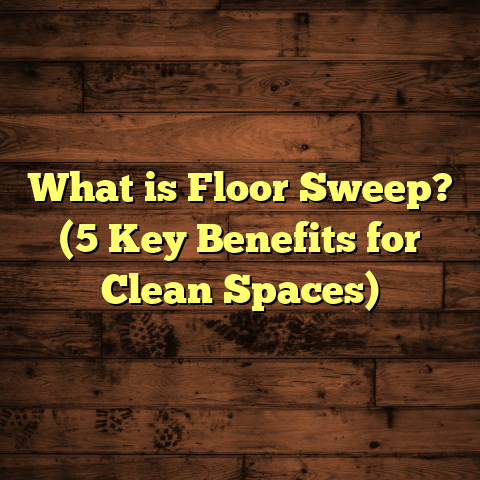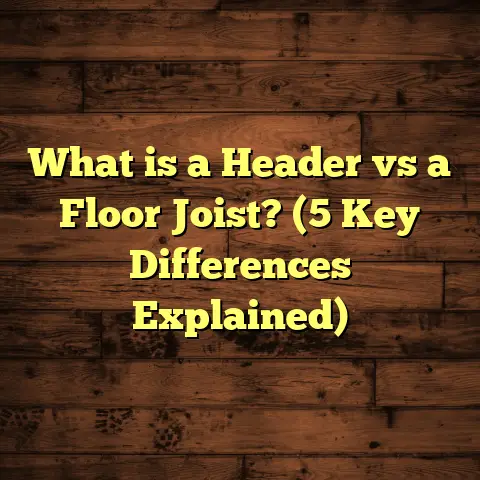What Is Varnished Hardwood Floors? (5 Key Benefits Explained)
I still remember the first time I walked into a home with freshly varnished hardwood floors. The moment my feet touched that smooth, glossy surface, I felt an immediate connection to the space. It wasn’t just about the beauty; the floor seemed to tell a story — one of craftsmanship, care, and timeless elegance. Since then, I’ve worked on hundreds of projects involving varnished hardwood floors, and each time I’m reminded why they remain such a popular choice for homeowners across the country.
Maybe you’re curious about what varnished hardwood floors really are, or wondering if they’re the right fit for your home. Maybe you want to know if they’re worth the cost and effort compared to other flooring options. Whatever your questions, I’ll share everything I’ve learned—from the technical details to personal stories—to help you understand the true value of varnished hardwood floors.
What Is Varnished Hardwood Flooring?
At its core, varnished hardwood flooring is exactly what it sounds like: hardwood planks finished with a protective varnish coating. But there’s more under the surface than that simple definition suggests.
Hardwood floors are made from solid wood harvested from deciduous trees like oak, maple, hickory, cherry, and walnut. These woods are prized for their strength and beautiful grain patterns. When milled into planks—usually about ¾ inch thick and between 2 ¼ to 5 inches wide—they provide a durable and elegant flooring base.
Once the wood planks are installed and nailed or glued down, they typically undergo a sanding process to create a perfectly smooth surface. After that comes the key step: applying varnish.
What Is Varnish Exactly?
Varnish is a clear finish made from resins dissolved in oils or solvents. It dries to form a hard, transparent film that seals the wood surface against moisture, dirt, and wear. The most common types used on hardwood floors today are polyurethane varnishes—either oil-based or water-based.
- Oil-based polyurethane: Offers excellent durability and a warm amber tone that enhances the wood’s color. It takes longer to dry (up to 24 hours) and has stronger fumes during application.
- Water-based polyurethane: Dries faster (usually in 2-4 hours), has less odor, and provides a clearer finish that doesn’t yellow over time. It’s becoming more popular for its eco-friendliness.
Typically, three to five coats of varnish are applied by professionals using brushes or rollers. Each coat is carefully sanded lightly after drying to ensure adhesion of the next layer and a smooth finish. The entire process can take anywhere from four days to two weeks depending on room size and drying conditions.
Why Is Varnish So Important for Hardwood Floors?
Without varnish, hardwood is vulnerable to moisture damage, scratches, stains, and fading. The varnish acts like armor that protects the wood while highlighting its natural grain and color. It also makes cleaning easier since liquids won’t soak in as quickly.
When I first started installing floors over 15 years ago, many homeowners chose wax finishes. But varnish quickly became the standard because it’s tougher and longer-lasting.
Five Benefits of Varnished Hardwood Floors That Make Them Worth Every Penny
After installing thousands of square feet of varnished hardwood floors in different climates and home styles, I’ve seen firsthand what makes this finish so special. Here are five key benefits that explain why I often recommend varnished hardwood floors.
1. Durability That Stands Up to Real Life
One of the biggest selling points for varnished hardwood floors is their incredible durability. The varnish creates a tough surface that resists scratches from pet claws, dropped objects, and heavy foot traffic.
According to data from the National Wood Flooring Association (NWFA), floors coated with high-quality polyurethane varnish can withstand wear for over 25 years before needing a major refinish. That’s significantly longer than carpet or laminate flooring.
I remember helping a family in Chicago whose oak floors had been varnished over 30 years ago. Despite their kids running around and a couple of big dogs regularly roaming the house, those floors still looked great after just a light sanding and new coats of varnish.
The secret lies in how each layer bonds tightly with the wood and previous coats. When the top layer starts to show wear, you don’t need to replace anything—you sand it down lightly and reapply varnish. This renews the floor’s protection without losing any wood thickness.
Hardwood vs Other Flooring Durability:
| Flooring Type | Average Lifespan | Scratch Resistance | Maintenance Frequency |
|---|---|---|---|
| Varnished Hardwood | 25+ years | High | Refinish every 10-15 years |
| Carpet | 5-7 years | Low | Replacement every few years |
| Laminate | 10-15 years | Medium | Replacement when worn |
| Vinyl | 10-20 years | Medium | Occasional repairs |
2. Timeless Beauty That Enhances Any Interior
The look of hardwood floors is hard to beat for adding warmth and character to a room. Varnish enhances this by deepening the wood grain’s natural colors and creating an inviting glow.
Whether you want a glossy sheen that reflects light like glass or a soft satin finish with understated elegance, varnished hardwood floors can be customized to your taste.
In my own house, I went for a matte water-based polyurethane finish on white oak floors. The subtle sheen lets natural light bounce softly around my living room without glare or shininess that can feel cold.
Recent surveys show over 60% of homeowners prefer hardwood flooring for its versatility—it works well with rustic décor as much as modern minimalist styles.
3. Maintenance That Fits Easily Into Busy Lives
One question I get all the time is: “How hard is it to keep these floors looking good?” The answer? Easier than you might think.
Once your floor is properly varnished, regular maintenance involves simple sweeping or vacuuming to remove dirt that could scratch the surface. A damp mop with a cleaner specifically designed for hardwood completes weekly cleaning.
Unlike waxed or unfinished wood floors—which need frequent polishing or oiling—varnished floors’ sealed surface resists stains and moisture. Spills can be wiped up quickly without penetrating into the wood.
I once worked on a project in Seattle where clients thanked me months after installation because their floors stayed stunning despite rainy weather and muddy shoes—something they struggled with on their old carpet.
4. Healthier Indoor Air Quality
Some homeowners worry about allergens trapped in flooring materials like carpets or synthetic rugs—especially if anyone in their family has allergies or asthma.
Varnished hardwood floors don’t trap dust mites or pet dander like carpet does. Instead, they’re easy to clean thoroughly every week.
Plus, modern water-based varnishes have very low volatile organic compound (VOC) emissions compared to older oil-based finishes. Fewer VOCs means less indoor air pollution during and after application—a big plus if you have kids or sensitive family members.
A study by the Environmental Protection Agency found homes with hardwood flooring tend to have lower indoor pollutants than those with wall-to-wall carpets.
5. Increased Home Value That Pays Off Long-Term
One of the most rewarding parts of my job is seeing how much value varnished hardwood floors add to homes on the market.
Realtors often highlight hardwood flooring as a key selling point because buyers see it as a durable investment worth paying extra for.
Data from Zillow in 2023 shows homes with well-maintained hardwood floors sold 4-6% faster and at prices 2-5% higher than comparable homes without them.
If you’re thinking about resale value down the line, investing $8-$15 per square foot now can boost your home’s appeal significantly.
More About My Personal Experiences With Varnished Floors
When I started out as a flooring contractor over 15 years ago, I worked mostly on basic installations using wax finishes or sealers. But once I saw how much longer varnish held up—and how much easier it was for homeowners—I switched entirely.
I still recall one project in Boston where we stripped old vinyl tile from a living room and installed quarter-sawn white oak planks with an oil-modified polyurethane varnish applied by hand with fine brushes. The homeowners were blown away when they saw how much depth and warmth it added compared to their previous flooring.
Over the years, I’ve learned that patience during application is key. Skipping drying times or rushing coats leads to bubbles or uneven surfaces that reduce lifespan.
In Vancouver recently, eco-conscious clients asked me about water-based varnishes for their heritage home because of lower odors and faster curing times. It cost about 15% more but was worth it for peace of mind about indoor air quality during renovation.
Deep Dive Into Installation & Costs: What You Should Expect
Let’s talk numbers because budgets matter when planning flooring projects.
Installation Process Overview
For an average room around 400 square feet:
- Preparation: Removing old flooring (if needed), cleaning subfloor
- Installation: Nailing or gluing down planks (takes about 1-2 days)
- Sanding: Creating smooth surface (1 day)
- Varnishing: Applying 3-5 coats with drying times in between (4-7 days)
- Curing: Avoid walking on floor for 3-7 days after final coat
Total time from start to finish usually runs between one and two weeks depending on size and climate humidity.
Cost Breakdown
| Item | Cost Range (USD) |
|---|---|
| Hardwood material | $3 – $6 per sq.ft |
| Labor installation | $5 – $9 per sq.ft |
| Varnish material | $0.50 – $1.50 per sq.ft |
| Labor finishing (varnish) | $1 – $3 per sq.ft |
| Additional supplies/tools | $200 – $500 total |
For example: A 500 sq.ft room in New York City might cost between $6,000 – $10,000 total installed depending on wood species and finish quality.
Wood Species Pricing Examples
- Oak: $4 – $6 per sq.ft
- Maple: $5 – $7 per sq.ft
- Walnut: $7 – $10 per sq.ft
- Exotic species (Brazilian cherry): $8 – $12 per sq.ft
Extended Case Study: Restoring Hardwood Floors in a Historic Charleston Home
A recent project of mine involved restoring an early 1900s craftsman-style home in Charleston with original pine flooring badly worn by decades of use.
We carefully stripped back layers of paint and old finishes before sanding down to bare wood planks. After repairing damaged boards by replacing some sections with matching reclaimed pine, we applied a satin water-based polyurethane varnish designed for historic properties.
The homeowners were thrilled at how it preserved the original character while adding modern durability. Their energetic dog tested those floors daily without leaving scratches or gouges after six months!
The project took about two weeks for roughly 600 square feet at a total price of $9,500 — right within typical regional budgets for quality restoration work.
Tips From My Workshop: Caring For Your Varnished Hardwood Floors
Here’s how I advise clients keep their varnished hardwood floors looking great for decades:
- Sweep/vacuum regularly using soft bristle attachments.
- Use microfiber damp mops with recommended cleaners—avoid harsh chemicals.
- Wipe spills immediately with dry cloth.
- Use furniture pads under legs to prevent dents.
- Avoid high heels or cleats indoors.
- Refinish every 10-15 years depending on wear.
- Maintain indoor humidity levels between 30–50% to prevent wood shrinking or swelling.
Final Thoughts — Is Varnished Hardwood Right For You?
In my experience working across diverse homes—from New England colonials to California beach houses—varnished hardwood floors consistently deliver unmatched beauty paired with practical durability.
If you value long-term investment in your home’s style and function—or want healthier indoor air combined with easy care—they’re worth serious consideration.
Are you curious about specific wood types or finishes? Want me to walk you through budgeting or installation timelines? Just ask! I’m here to help you make confident flooring choices based on real-world knowledge—not just marketing hype.
